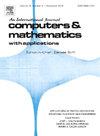寄生模式对稳定晶格玻尔兹曼方案和弱不稳定多步有限差分方案的影响
IF 2.5
2区 数学
Q1 MATHEMATICS, APPLIED
引用次数: 0
摘要
线性常系数多步有限差分方案的数值分析是一个历史悠久的课题,大约在五十年前就已提出。它依赖于方案的稳定性,因此,在 L2 设置下,单位圆上不存在放大多项式的多个根。这样,在讨论方法的收敛性时,就可以将对方案一致性的研究与对其寄生/杂散模式的精确了解分离开来,从而使方法的研究本质上如同它们只有一个步骤一样。此外,稳定性还减轻了深入研究计算机浮点运算复杂性的需要,而解决浮点运算可能是具有挑战性的课题。在本文中,我们证明了在单位圆上有多个根的 "弱 "不稳定有限差分方案的情况下,虽然方案可能保持稳定,但考虑寄生模式对于研究其一致性以及收敛性至关重要。这项研究的起因是关于稳定晶格玻尔兹曼方案的意想不到的数值结果,这些方案可以用多步有限差分方案来重写。与有限差分方案不同,格子波尔兹曼方案的严格数值分析是一个当代课题,还有许多有待未来发现。最初的预期是,三阶初始化方案足以保持四阶方案的精度。然而,对于弱不稳定的有限差分方案和稳定的格点玻尔兹曼方法来说,这一假设被证明是不正确的。这种边缘情况突出表明,对于格点玻尔兹曼方法必须特别小心,而且真正的稳定性对于促进构建类似拉克斯-里奇特米尔定理的方法和掌握有关有限差分方法的舍入误差的影响具有重要意义。尽管本文通篇考虑的匀速线性输运方程简单且明显缺乏实际应用,但我们证明了该方程的高阶晶格玻尔兹曼方案可用于处理非线性守恒定律系统,并依赖于金-新近似和高阶分裂公式。本文章由计算机程序翻译,如有差异,请以英文原文为准。
The influence of parasitic modes on stable lattice Boltzmann schemes and weakly unstable multi-step Finite Difference schemes
Numerical analysis for linear constant-coefficient multi-step Finite Difference schemes is a longstanding topic, developed approximately fifty years ago. It relies on the stability of the scheme, and thus—within the setting—on the absence of multiple roots of the amplification polynomial on the unit circle. This allows for the decoupling, while discussing the convergence of the method, of the study of the consistency of the scheme from the precise knowledge of its parasitic/spurious modes, so that the methods can be essentially studied as if they had only one step. Furthermore, stability alleviates the need to delve into the complexities of floating-point arithmetic on computers, which can be challenging topics to address. In this paper, we demonstrate that in the case of “weakly” unstable Finite Difference schemes with multiple roots on the unit circle, although the schemes may remain stable, considering parasitic modes is essential in studying their consistency and, consequently, their convergence. This research was prompted by unexpected numerical results on stable lattice Boltzmann schemes, which can be rewritten in terms of multi-step Finite Difference schemes. Unlike Finite Difference schemes, rigorous numerical analysis for lattice Boltzmann schemes is a contemporary topic with much left for future discoveries. Initial expectations suggested that third-order initialization schemes would suffice to maintain the accuracy of fourth-order schemes. However, this assumption proved incorrect for weakly unstable Finite Difference schemes and for stable lattice Boltzmann methods. This borderline scenario underscores that particular care must be adopted for lattice Boltzmann schemes, and the significance of genuine stability in facilitating the construction of Lax-Richtmyer-like theorems and in mastering the impact of round-off errors concerning Finite Difference schemes. Despite the simplicity and apparent lack of practical usage of the linear transport equation at constant velocity considered throughout the paper, we demonstrate that high-order lattice Boltzmann schemes for this equation can be used to tackle nonlinear systems of conservation laws relying on a Jin-Xin approximation and high-order splitting formulæ.
求助全文
通过发布文献求助,成功后即可免费获取论文全文。
去求助
来源期刊

Computers & Mathematics with Applications
工程技术-计算机:跨学科应用
CiteScore
5.10
自引率
10.30%
发文量
396
审稿时长
9.9 weeks
期刊介绍:
Computers & Mathematics with Applications provides a medium of exchange for those engaged in fields contributing to building successful simulations for science and engineering using Partial Differential Equations (PDEs).
 求助内容:
求助内容: 应助结果提醒方式:
应助结果提醒方式:


